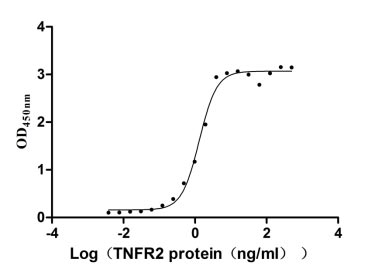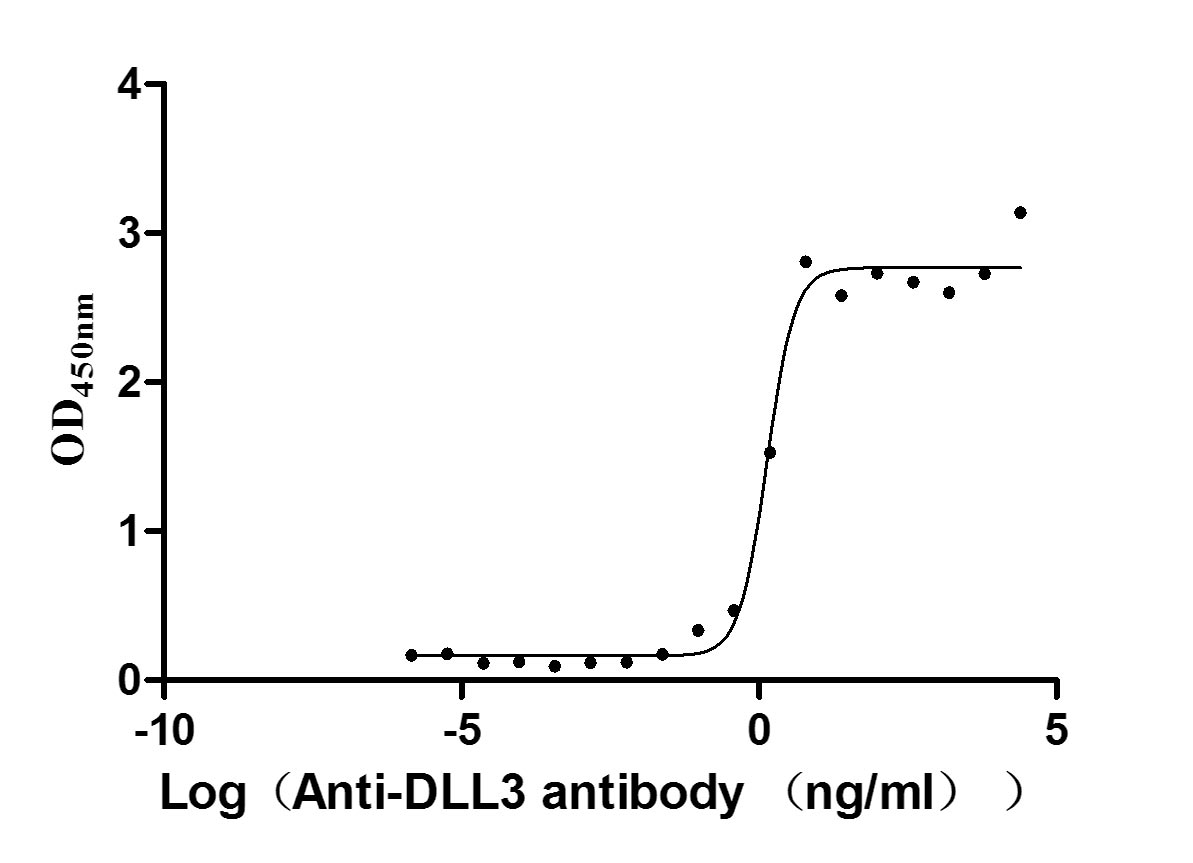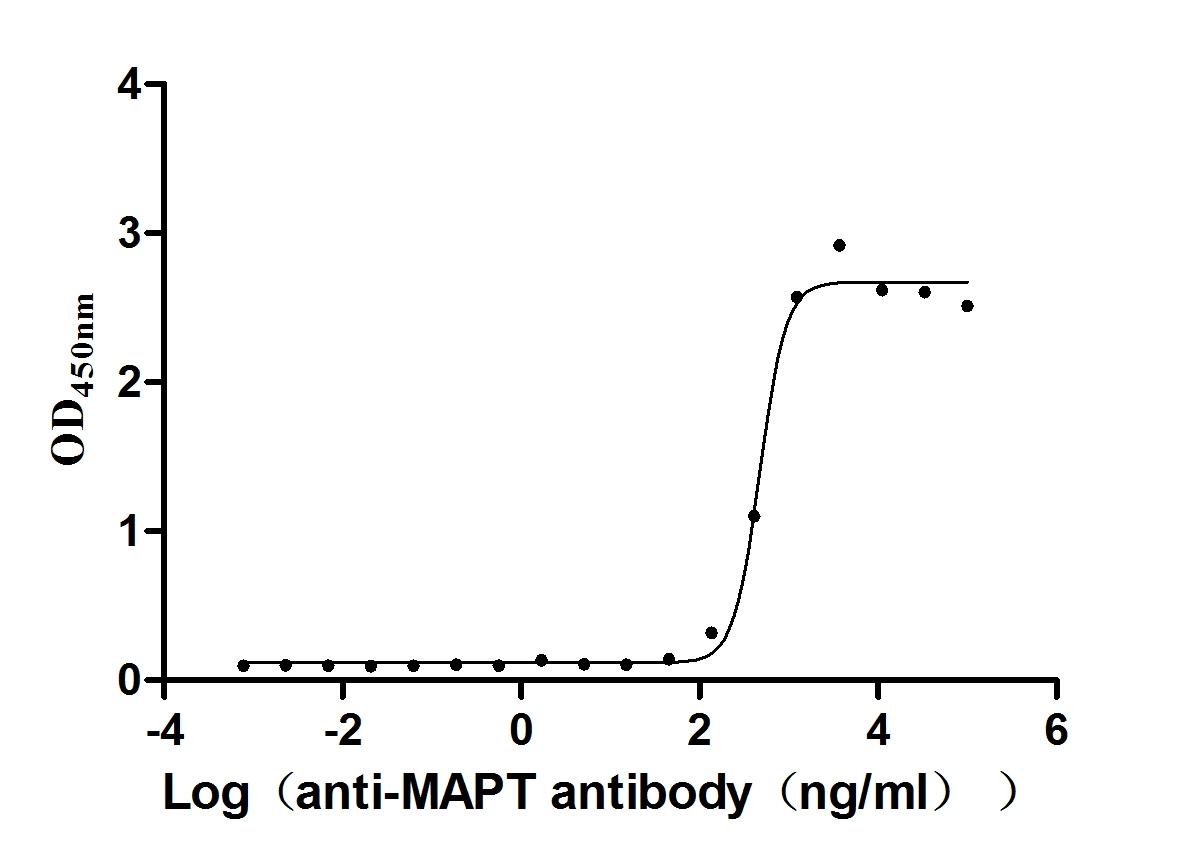Recombinant Macaca mulatta Tripartite motif-containing protein 5 (TRIM5)
-
中文名称:猕猴TRIM5重组蛋白
-
货号:CSB-YP609535MOW
-
规格:
-
来源:Yeast
-
其他:
-
中文名称:猕猴TRIM5重组蛋白
-
货号:CSB-EP609535MOW
-
规格:
-
来源:E.coli
-
其他:
-
中文名称:猕猴TRIM5重组蛋白
-
货号:CSB-EP609535MOW-B
-
规格:
-
来源:E.coli
-
共轭:Avi-tag Biotinylated
E. coli biotin ligase (BirA) is highly specific in covalently attaching biotin to the 15 amino acid AviTag peptide. This recombinant protein was biotinylated in vivo by AviTag-BirA technology, which method is BriA catalyzes amide linkage between the biotin and the specific lysine of the AviTag.
-
其他:
-
中文名称:猕猴TRIM5重组蛋白
-
货号:CSB-BP609535MOW
-
规格:
-
来源:Baculovirus
-
其他:
-
中文名称:猕猴TRIM5重组蛋白
-
货号:CSB-MP609535MOW
-
规格:
-
来源:Mammalian cell
-
其他:
产品详情
-
纯度:>85% (SDS-PAGE)
-
基因名:TRIM5
-
Uniprot No.:
-
别名:TRIM5; Tripartite motif-containing protein 5; EC 2.3.2.27; RING-type E3 ubiquitin transferase TRIM5; TRIM5alpha
-
种属:Macaca mulatta (Rhesus macaque)
-
蛋白长度:full length protein
-
表达区域:1-497
-
氨基酸序列MASGILLNVK EEVTCPICLE LLTEPLSLHC GHSFCQACIT ANHKKSMLYK EGERSCPVCR ISYQPENIQP NRHVANIVEK LREVKLSPEE GQKVDHCARH GEKLLLFCQE DSKVICWLCE RSQEHRGHHT FLMEEVAQEY HVKLQTALEM LRQKQQEAEK LEADIREEKA SWKIQIDYDK TNVSADFEQL REILDWEESN ELQNLEKEEE DILKSLTKSE TEMVQQTQYM RELISELEHR LQGSMMDLLQ GVDGIIKRIE NMTLKKPKTF HKNQRRVFRA PDLKGMLDMF RELTDARRYW VDVTLAPNNI SHAVIAEDKR QVSSRNPQIM YQAPGTLFTF PSLTNFNYCT GVLGSQSITS GKHYWEVDVS KKSAWILGVC AGFQSDAMYN IEQNENYQPK YGYWVIGLQE GVKYSVFQDG SSHTPFAPFI VPLSVIICPD RVGVFVDYEA CTVSFFNITN HGFLIYKFSQ CSFSKPVFPY LNPRKCTVPM TLCSPSS
-
蛋白标签:Tag type will be determined during the manufacturing process.
The tag type will be determined during production process. If you have specified tag type, please tell us and we will develop the specified tag preferentially. -
产品提供形式:Lyophilized powder
Note: We will preferentially ship the format that we have in stock, however, if you have any special requirement for the format, please remark your requirement when placing the order, we will prepare according to your demand. -
复溶:We recommend that this vial be briefly centrifuged prior to opening to bring the contents to the bottom. Please reconstitute protein in deionized sterile water to a concentration of 0.1-1.0 mg/mL.We recommend to add 5-50% of glycerol (final concentration) and aliquot for long-term storage at -20℃/-80℃. Our default final concentration of glycerol is 50%. Customers could use it as reference.
-
储存条件:Store at -20°C/-80°C upon receipt, aliquoting is necessary for mutiple use. Avoid repeated freeze-thaw cycles.
-
保质期:The shelf life is related to many factors, storage state, buffer ingredients, storage temperature and the stability of the protein itself.
Generally, the shelf life of liquid form is 6 months at -20°C/-80°C. The shelf life of lyophilized form is 12 months at -20°C/-80°C. -
货期:Delivery time may differ from different purchasing way or location, please kindly consult your local distributors for specific delivery time.Note: All of our proteins are default shipped with normal blue ice packs, if you request to ship with dry ice, please communicate with us in advance and extra fees will be charged.
-
注意事项:Repeated freezing and thawing is not recommended. Store working aliquots at 4°C for up to one week.
-
Datasheet :Please contact us to get it.
靶点详情
-
功能:Capsid-specific restriction factor that prevents infection from non-host-adapted retroviruses. Blocks viral replication early in the life cycle, after viral entry but before reverse transcription. In addition to acting as a capsid-specific restriction factor, also acts as a pattern recognition receptor that activates innate immune signaling in response to the retroviral capsid lattice. Binding to the viral capsid triggers its E3 ubiquitin ligase activity, and in concert with the heterodimeric ubiquitin conjugating enzyme complex UBE2V1-UBE2N (also known as UBC13-UEV1A complex) generates 'Lys-63'-linked polyubiquitin chains, which in turn are catalysts in the autophosphorylation of the MAP3K7/TAK1 complex (includes TAK1, TAB2, and TAB3). Activation of the MAP3K7/TAK1 complex by autophosphorylation results in the induction and expression of NF-kappa-B and MAPK-responsive inflammatory genes, thereby leading to an innate immune response in the infected cell. Restricts infection by human immunodeficiency virus type 1 (HIV-1) and simian immunodeficiency virus (SIV-agm). Plays a role in regulating autophagy through activation of autophagy regulator BECN1 by causing its dissociation from its inhibitors BCL2 and TAB2. Also plays a role in autophagy by acting as a selective autophagy receptor which recognizes and targets HIV-1 capsid protein p24 for autophagic destruction.
-
基因功能参考文献:
- Data suggest that SPRY domain of TRIM5a is essential in activation of AP-1 signaling but not NF-kappaB signaling in this species. (TRIM5a = tripartite motif-containing 5 alpha isoenzyme; AP-1 = activator 1 protein) PMID: 29196608
- High resolution crystal structure of a Trim5Alpha dimeric Bbox domain. PMID: 27402535
- L2 region of the TRIM5alpha dimer undergoes dynamic conformational changes, which results in the displacement of L2 regions by 25 angstroms relative to each other. PMID: 27821283
- HIV-1 virus target the rhTRIM5alpha enhanced the susceptibility to HIV-1 infection. PMID: 27888407
- Mutations in gag and pol are associated with escape of HIV-1 from rhTrim5alpha. PMID: 26469551
- These studies provide direct evidence that ubiquitin conjugation to rhTRIM5alpha-containing complexes is required for inhibition of HIV-1 Reverse Transcription and Capsid Destabilization. PMID: 26676782
- These results confirm that the SUMO machinery is involved in TRIM5alpha-mediated retroviral restriction, and demonstrate that TRIM5alpha is a SUMO 1 and SUMO 2 substrate. PMID: 25880753
- These data show that there could be some distinct HIV-1 capsid patterns to confer significant resistance to rhesus TRIM5-alpha. PMID: 25195168
- s found that TRIM5alpha restriction significantly delayed disease progression and improved the survival rate of simian immunodeficiency virus-infected macaques. PMID: 25473059
- Analysis of TRIM genotype revealed a potential role for TRIM in disease development in the central nervous system. 5 of 5 animals with the permissive TRIM5alpha genotype (TRIMQ/Q) progressed to Simian Immunodeficiency Virus Encephalitis. In contrast, 2 animals with the restrictive TRIM5alpha genotype (TRIMTFP/TFP) did not show neurologic signs, nor did they develop SIVE. PMID: 25187546
- Data show that rhTRIM5alpha is stable and able to accumulate in cytoplasmic bodies, as well as to potently block HIV-1 infection. PMID: 24662946
- Rhesus TRIM5alpha acts as an autophagic receptor to restrict HIV-1 through autophagic degradation. PMID: 25127057
- In conclusion, the TRIM5alpha sumoylation site appears to modulate the E3 ubiquitin ligase activities of the adjacent RING domain, promoting K63-linked ubiquitin chains at the expense of auto-ubiquitylation which is probably K48-linked. PMID: 24583231
- The antiparallel organization of the NtD regions of Fv1 and Trim5alpha dimers correctly positions C-terminal specificity and N-terminal effector domains and facilitates stable binding to adjacent capsid hexamers in viral cores. PMID: 24979782
- Taken together, it is likely that rhTRIM5alpha cytoplasmic bodies are involved in recruiting components of the ubiquitin-proteasome system to coordinate proteasomal destruction of a viral or cellular protein(s) during restriction of HIV-1. PMID: 23799296
- Assisted evolution enables HIV-1 to overcome a high TRIM5alpha-imposed genetic barrier to rhesus macaque tropism. PMID: 24086139
- direct evidence that TRIM5alpha exerts selective pressure on the cross-species transmission of SIV in primates. PMID: 23990789
- PRYSPRY domain serves an unknown function, distinct from the binding of TRIM5alpharh to the HIV-1 core. PMID: 24314652
- influence of the TRIM5 genotype on susceptibility to rectal S(H)IV infection and on plasma viremia PMID: 23461569
- Virus-specific effects of TRIM5alpha(rh) RING domain functions on restriction of retroviruses. PMID: 23637418
- These results suggest that the rhTRIM5alpha B30.2/SPRY domain is not only important for the recognition of the HIV-1 CA, but it is also important for its association with SUMO-1 or SUMO-1 modified proteins. PMID: 23369348
- The recognition of the entire capsid surface is a general strategy for TRIM5alpha to restrict murine leukemia viruses. PMID: 23536686
- TRIMCyp individuals were identified in Chinese M. mulatta originating from Yunnan, although multiple earlier studies failed to find CypA retrotransposition in this subspecies. TRIMe7-CypA was expressed in M. mulatta. PMID: 23233150
- Our results do not support a role for SUMO-interacting motifs or SUMOylation in the antiviral properties of TRIM5alpha. PMID: 23084420
- Combined cryo-electron microscopy and biochemical data show that the monomeric rhesus TRIM5alpha PRY/SPRY, but not the human TRIM5alpha PRY/SPRY domain, can bind to HIV-1 capsid protein assemblies without causing disruption of the capsid. PMID: 23091002
- TRIM5alpha utilizes proteasome during HIV-1 virus restriction. PMID: 22624877
- A high-resolution structure of a TRIM5alpha PRYSPRY domain, the PRYSPRY of the rhesus monkey TRIM5alpha that potently restricts HIV infection, is reported. PMID: 22847415
- results suggest that TRIM5alpha(rh) blocks HIV-1 reverse transcription by inducing premature viral uncoating in target cells. PMID: 22114335
- TRIM5alpha represses HIV-1 LTR promoter activity by negatively regulating TAK1/TAB1/TAB2/TAB3-complex-mediated NF-kappaB activation. PMID: 21918865
- The s observed a significant effect of TRIM5 genotype on mucosal simian immunodeficiency virus SIVsmE660 acquisition in that no virus transmission occurred in monkeys with only restrictive TRIM5 alleles. PMID: 21775457
- Animals coexpressing the TRIM5(TFP) and TRIM5(CypA) alleles took significantly longer to become infected with SIVsmE660, but not SIVmac239, after repeated limiting-dose intrarectal challenge. PMID: 21734037
- Overall, these results demonstrate a role for TRIM5alpha self-ubiquitylation in the ability of TRIM5alpha to restrict HIV-1. PMID: 21734049
- The s discovered the ability of human and rhesus TRIM5alpha to shuttle into and out of the nucleus. PMID: 21575157
- The B-box 2, coiled-coil and linker 2 regions of TRIM5a form a core dimerization motif that exhibits a high level of alpha-helical content. PMID: 21205312
- TRIM5 can suppress SIV replication in vivo, exerting selective pressure during the initial stages of cross-species transmission. PMID: 20808775
- G116E substitution in the capsid protein of the HIV-1 recombinant NL-4/5S6/7SvifS virus rendered the virus resistant to cynomolgus monkey, but not human TRIM5 alpha-mediated restriction. PMID: 20609213
- Mamu-A*012 status was associated with significantly more frequent death (P = 0.04) as was TRIM5 alleles 6-11 PMID: 20585621
- Collectively, these results suggest that TRIM5alpha-dependent restriction of HIV-1 infection results from structural perturbation of the viral capsid leading to aberrant HIV-1 uncoating in target cells. PMID: 20410272
- These results suggest that Hsp70 plays critical roles in the cellular management against the TRIM5alpha-induced cellular insults. PMID: 20053985
- Results suggest that the TRIM5alpharh-mediated late restriction involves (i) interaction with HIV-1 Gag polyprotein, and (ii) an effector function(s) that depends upon the coiled-coil and linker 2 domains of TRIM5alpharh. PMID: 19951947
- inhibits herpes simplex virus at the early stage of infection PMID: 20060996
- These findings demonstrate a central role for TRIM5alpha in limiting the replication of an immunodeficiency virus infection in a primate host. PMID: 20107597
- TRIM5alpha blocks HIV-1 production by actively degrading the viral Gag protein. [TRIM5alpha] PMID: 17435772
- Some alterations in the TRIM5alpha B-box 2 domain apparently affect the orientation or conformation of the B30.2(SPRY) domain, influencing capsid recognition. PMID: 17543365
- We observe that proteasome inhibition allows HIV-1 to remain stably sequestered into large rhTRIM5alpha cytoplasmic bodies, preventing the clearance of HIV-1 viral complexes from the cytoplasm and revealing an intermediate in the restriction process. PMID: 18250195
- lack of activity against HIV-1 suggests that Mamu7 homozygous animals will be null for TRIM5-mediated restriction of HIV-1 PMID: 18287035
- We present here the NMR structure of the TRIM5 B-box 2 domain and identify an unusual hydrophobic patch on the domain surface important for self association, capsid binding avidity, and retrovirus restriction. PMID: 19656869
显示更多
收起更多
-
亚细胞定位:Cytoplasm. Nucleus.
-
蛋白家族:TRIM/RBCC family
-
数据库链接:
KEGG: mcc:574288
STRING: 9544.ENSMMUP00000000454
UniGene: Mmu.3751
Most popular with customers
-
Recombinant Human Tumor necrosis factor receptor superfamily member 1B (TNFRSF1B), partial (Active)
Express system: Mammalian cell
Species: Homo sapiens (Human)
-
Recombinant Human Delta-like protein 3 (DLL3), partial (Active)
Express system: Mammalian cell
Species: Homo sapiens (Human)
-
Recombinant Mouse Microtubule-associated protein tau (Mapt) (Active)
Express system: Mammalian cell
Species: Mus musculus (Mouse)
-
Express system: Mammalian cell
Species: Homo sapiens (Human)
-
Recombinant Human Alkaline phosphatase, germ cell type (ALPG) (Active)
Express system: Mammalian cell
Species: Homo sapiens (Human)
-
Recombinant Human Cadherin-17 (CDH17), partial (Active)
Express system: Mammalian cell
Species: Homo sapiens (Human)
-
Recombinant Human Serine/threonine-protein kinase receptor R3 (ACVRL1), partial (Active)
Express system: Baculovirus
Species: Homo sapiens (Human)
-
Recombinant Macaca fascicularis C-type lectin domain family 4 member C(CLEC4C), partial (Active)
Express system: Mammalian cell
Species: Macaca fascicularis (Crab-eating macaque) (Cynomolgus monkey)




















